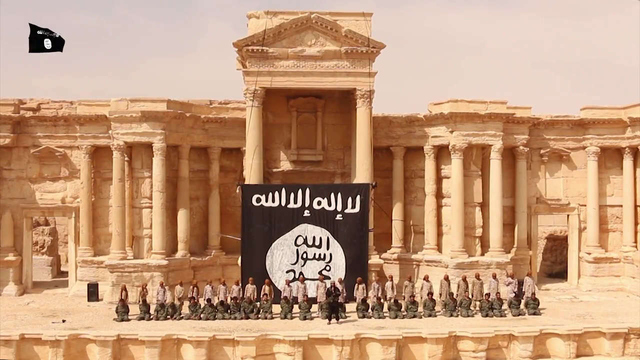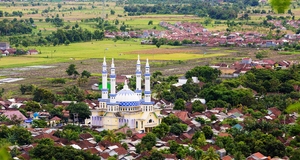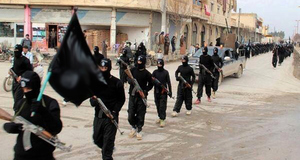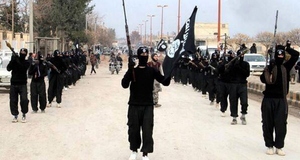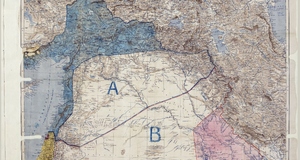Featured Article:ISIS and the Global Image War: An Archival Perspective on Iconoclastic Performance and Bio-Political Authority
By
2016, Vol. 8 No. 11 | pg. 1/1
IN THIS ARTICLE
KEYWORDS
The so-called Islamic State of Iraq and Syria (ISIS) – also known as ISIL, IS and Daesh – has during the last years disseminated videos throughout the Internet in a new recruitment and media strategy focusing on the destruction of cultural heritage. This phenomenon will be used as a point of departure to reflect on the related global image war and the accompanying dissemination of moving images through multimedia archives and pseudo-archives on the Internet. Drawing mainly from Pasi Väliaho – but also Wolfgang Ernst, Ömür Harmanșah and Charles Merewether – I discuss how ISIS, in a highly technologically conscious way, is launching a campaign of violent imagery with the aim to target humans on an “evolutionary level.” I further argue that related contemporary image wars should best be understood as taking place at the level of immunopolitics. Finally, from the perspective of media archaeology, I end with a discussion on the digital archives utilized by ISIS – a discussion which ties in with more general notions of archival inscription, storage and access. ISIS’s videos are created to achieve fear and anxiety, to define and capture humans in a psychobiological state of emergency
A still frame from an ISIS video depicting the mass execution of Syrian soldiers at the ancient city of Palmyra, which was captured and ransacked by ISIS in May 2015.
Performing IconoclasmSince 2014 ISIS has, besides their earlier violent abuses and beheadings, waged an infamous campaign against cultural heritage in northern Iraq and Syria – damaging museums and archaeological sites in Mosul, Nimrud, Hatra, et al., filming it and disseminating the resulting videos on the Internet.1 In turn, the moving images have been spread through traditional mainstream media, resulting in what Ömür Harmanșah has called a counter-heritage campaign as a “media performance on a global scale.”2 The key word to consider here is performance – what it entails is a discursive critique of the disseminated images: that they are not just objective documentary evidence of an event, but rather a performative, staged spectacle with the video as the goal in itself. In other words, ISIS’s bio-politics are constituted by the very aim of reaching different media outlets. To look at the videos as purely observational or only questioning the authenticity of their contents (if some sculptures are real relics, if a hostage was really killed, etc.) fails to see ISIS’s actual production and dissemination of images, leading to the effective depoliticization of the practice. It would also suit ISIS’s official narrative – that they are iconoclasts; that they are fighting idolatry and false gods just as in the 7th century.3 With a critical reading of discourse the practice could rather be seen as a technologically conscious re-enactment of iconoclasm which serves as a media performance that “mobilizes the consumerism of visual media.”4 ISIS’s practice of disseminating videos could be described as the inversion of what Pasi Väliaho talks about when he addresses the new techniques of psychiatric power that have emerged in the media and military; helping to prepare for war as well as to offer therapeutic support to military veterans.5 Needless to say, ISIS’s videos are not created to deal with fear and anxiety, but rather they are created to achieve those very reactions – to define and capture humans in a psychobiological state of emergency.6 Väliaho’s line of thinking on these lines at least seems applicable to the more violent of ISIS’s imagery, like their videos of beheadings, in which the apparent lack of respect for human life and the brutal inscription of history with violence or “performative violence” is used as primary means of creating fear and anxiety in the viewer. It should also be noted at this point that of course the aim of such videos is (at least) twofold – for instance, it is presumably also to attract new recruits. This is my initial reading of the ISIS images – I will come back to a discussion on how they function further on. But in order for such a discussion to be productive, we need to look at the broader archival context within which the imagery is disseminated and consumed. The Archival DispositiveDrawing from the work of Bessel van der Kolk, Charles Merewether writes about Shomei Tomatsu's artistic photography essays dealing with the aftermath of the Nagasaki bomb. The photographs acknowledge discontinuities between the document and the referent – by re-staging or repeating the original event – and also show how the traumatic event caused “unassimilated,” “overwhelming” experiences which need to be transferred into narratives.7 Through photographed, metonymic objects the event is again actualized and present, bringing into focus the two separate times – the traumatic past as well as the remaining pain of the present. This is echoed in Immersion: Serious Games 3 (Harun Farocki, 2009), a documentary essay film in which Farocki explores the shift in how the contemporary human being is seen and governed by looking at how virtual reality is used as a technique to treat the trauma of U.S. Iraq veterans. Echoing Van der Kolk, the aim of the U.S. military is indeed to rewrite the traumatic event with a fresh narrative. And as in Väliaho, it seems in Farocki’s images that fear and anxiety – preindividual traits shared among humans as a species – are targets for control in the neoliberal world. Exploring the same virtual reality technique but also in its function of training U.S. soldiers for Iraq, Väliaho suggests that the way liberal democracies wage wars has taken its toll on their soldiers’ “affective life” (post-traumatic stress disorder, etc.) and thus has “necessitated bio-political governance to revisit and revise the past so as to (re)produce subjects amenable to the contingencies of war.”8 Virtual reality exposure of this military kind is of course done with special techniques (stereoscopic 3D glasses, headphones, props, etc.). My assumption is that the ISIS videos will mainly be consumed on cell phones and computers screens through multimedia archives (social media, websites, etc.) and on TV screens through mainstream media (news reports and the like). Needless to say, this means that the moving images of the U.S. military and ISIS, respectively, will not be consumed within the same kind of dispositional context. It is a seemingly important difference, but where should the line of distinction be drawn more exactly? According to Väliaho, one thing that distinguishes the military’s virtual reality is the way it seeks to enter the brain’s “endogenous production of images” – that is to say, that the images originate from the human organism itself.9 The virtual reality environment is able to achieve this by exploiting the brain’s inherent plasticity – its ability to readjust and recreate its neural connections, constantly.10 Is this also the case with the ISIS videos, since they seek to release fear and anxiety? One thing that seems different at a first glance is virtual reality’s specific way of substituting direct human perception; the experience and phenomenological aspects of war, so to speak. But, importantly, it could also be understood as possible with a conception of trauma as organized in a specific way. Trauma and The Archival Inscription of ViolenceDiscussing the human perception in relation to trauma, Väliaho is referencing van der Kolk, who claims that the memories of trauma may carry no verbal, explicit component but are rather taking place on an “implicit or perceptual level” and without any representational narrative.11 According to van der Kolk this also implies that the traumatized person carries memories that are tied not only to personal experiences, but to evolutionary functions as well.12 That is, that the emotional experiences function in order to organize the organism’s “survival responses.”13 In the U.S. military example, the virtual reality environment thus serves to train for such experiences – to make the bodily functions more tolerant to stress at the “evolutionary level” – and also to return to past experiences in order to help in the rewriting of memory, as Farocki's images also show. According to Väliaho, one way of achieving this is to “open up pathogenic affects for modification by exposing the subject to ‘feared stimuli’.”14 This means that in the training and treatment the subjects will experience the simulation of violent, traumatic scenes (like the ones they have or may experience). Although there are differences, this indeed seems like a strong parallel to the ISIS videos. At least the effect is similar – the ISIS videos are violent (and in a way traumatic in themselves), releasing a visceral effect in the viewer which is hard to evade and targeting not the higher cognitive faculties but rather the pre-cultural level of the human organism.15 The end goal obviously differs but it seems like the moving images of the U.S. military and ISIS, respectively, are targeting the same domain of the human psyche. As I will argue further on, I think they are actually both contesting over the human organism on an “evolutionary level,” much in the same way as Väliaho writes that in military virtual reality the psyche appears as the actual “war zone.”16 Drawing from Foucault, Väliaho argues that human affective life is in fact the guiding principle for governments in their efforts to administer the emergency of life.17 In that way the general bio-political governance coincides with the virtual reality practices described above. Again drawing from Foucault, Väliaho stresses that this technological preservation or safeguarding of life also will bring forces that try to “annihilate life.”18 This is part of what Väliaho calls immunopolitics. He says immunity in this respect should be understood as the governmental power to defend life, as outlined above, but also that it implies “violently incorporating the exterior."19 To Väliaho, the war over the organism therefore corresponds to the “economic-political logic of contemporary wars” waged by western liberal societies.20 He further argues that the incorporation of the exterior is in parallel to virtual reality and the general bio-political aim of tapping into the brain’s own image production and eliminating all outside threats.21 This “immunitary logic” is a paradox according to Väliaho, because what in first instance is self-preservation then actually turns into self-destruction:
The quote leads us back to the main question of the current essay, namely what the images can achieve in terms of playing a part in these immunopolitics. When it comes to military virtual reality, the answer has already been touched upon through Väliaho. But in fact, also the ISIS can be connected to what Väliaho calls “the more general autoimmunitary crisis” of the global consumption of violent imagery. The key point he makes is that just as the military virtual reality these images originate not so much from what they actually show but from their “modular nature” – the endogenous production of images – which makes the subject “violently attack any element of threat, even itself.”23 These violent images – like the ISIS videos – pierce the highly saturated media noise, with their extreme graphic content and underpinned by new technologies and the global economy, in what Bruno Latour has called “iconoclash:"
To further explore ISIS's role in these “image wars” it is fruitful to move beyond the level of discourse, iconology and cultural history towards the “cold gaze” of media archaeology. From this perspective we can see how the archives actualized so far in this text are regulated more concretely and inherently by their technological frameworks. Needless to say, it is not possible to cover or exhaustively explore the almost infinite questions that the ISIS videos raise in relation to media archaeology. The aim is rather to outline how the technological framework specific to the ISIS videos has important implications for political and aesthetic frameworks of reception. “Desemantizing” ISISInteresting in relation to Bruno Latour's notion of iconoclash, Wolfgang Ernst writes about television and how it constantly has to provide the unexpected. He cites Kay Kirchmann, who claims that “[...] 'ideal television is the unpredictable under total control of its mise-en-scene.'”25 The unpredictable is especially highlighted in television when it is recorded and thus can be replayed. Still, television news programs were at first tied to the condition of strictly live broadcasting. That is, the event and the news of an event were at first intertwined. But with the technological development television was quick to exploit “the paradox of magnetic storage and live effect.”26 What this means is that the catastrophic is “closest to the medium itself,” from the media archaeological perspective, according to Ernst.27 There is a meta-level, if you will, to this – the medium is playing itself and its possibilities. In fact, to Ernst this “meta-level” means that the distinction between signifier and signified is eliminated in a process of “desemanticizing,” in which meaning turns into “media-archaeological material.”28 Still, there is a big difference between TV and the digital archives actualized in my discussion of ISIS. The digital archives have “on and off” access to images, in analogy to the underlying binary codes – as a user you're not zapping the flows of television but managing time discretely, allowed by the coded bits.29 The “hypertextual logic” prevalent in most multimedia archives means there is a special linkage of media and a simultaneous access at various levels. To Ernst, what is also the fundamental difference from television, for example, is that an Internet database is an “aggregate of unpredictable texts, sounds, images, data, and programs.”30 The term multimedia archive for these kinds of databases is still a bit misplaced, because the ostensible “multiple media” on a computer screen is only a simulation for the human perception taking place on a surface level – the computer medium is really just one medium in virtual space.31 In contrast to early television, as described above, YouTube clips and the documents of most digital archives can in theory be uploaded, stored and accessed at any time – “digital archives” in this context denoting mainly social media and other pseudo-archives on the Internet. To clarify the terminology further, most of large searchable databases on the Internet can be labeled pseudo-archives. But, importantly, a pseudo-archive can't have the detailed metadata and the authorized selection and commission which characterizes a larger official archival institution (in a strict legal-administrative sense). By this definition YouTube would be the current example par excellence in terms of moving image pseudo-archives. According to Ernst, what characterizes such a digital archive is that it is “(co-)produced by online users for their own needs.”32 But what is of most interest are the factors that still will regulate a pseudo-archive like YouTube beyond the influence of its users. Because even if in theory you can upload “anything at any time,” in reality you cannot. Online, there is no sealed off data from access as there is in the traditional institutional archive – online it is about “'bringing it in, checking it out, constantly evaluating.'”33 To Ernst, this means that the archival media memory is demonumentalized.34 But there is still “material memory agencies” – hardware and institutions – which legally and technically will regulate what is stored.35 The content of a digital archive – the semantic messages – will in fact be formatted as an effect of the “mediality of hardware and software.”36 In the case of YouTube there are limitations and rules connected to hardware and software (length, data size, copyright, etc.) stipulating what kind of digital signals that can be transmitted to their servers and in turn published and streamed in the form of visual representations – “video clips” – on their website. The transmitted data signals will automatically (algorithmically) be processed in order to follow these rules and regulations. In a digital archive such as YouTube, the arché – as used in Foucauldian terminology – is therefore really situated at the level of the source code, which is regulated by algorithmic dynamics.37 It is not only shaping any given appearance of statements but at “the root” it defines the system of the statement-event’s enunciability.38 This of course ties into more general questions concerning archival inscription, storage and access – and even ontology. For one, to research YouTube and other Internet archives demands a new type of research and archival practice. YouTube is not an archive in a strict sense and it also doesn't contain photographic documents which necessarily can be seen as indexical or “proof.” As Giovanna Fossati points out, in general, the transition to digital archives brings with it a lot of such challenges.39 But, she also points out that the ontology of the artifact is just one side of the coin – we mustn't forget Deleuze's approach of film/mind, i.e., what effects the images will have on the brain (and that is why Väliaho is a good starting point for the ISIS videos).40 All of this of course ultimately will come down to the broader ongoing discussions on film ontology and film theory in general.41 To conclude, it is important to note that the imagery discussed is very much situated in a political and historical context – in fact, the images reflected on originate from the same conflict. The soldiers seen in Farocki’s images and the ISIS videos are both connected to a geopolitical conflict zone, namely the Middle East and in particular Iraq. They could also be connected to the highly inflated discourse on terrorism, the so-called West-East conflict and the “post-9/11” U.S. foreign policies. As I have at least in part shown, the ISIS videos are constitutive elements of this ongoing conflict. But as outlined in this essay, they are not only polarizing on a discursive level – that is, reproducing the “West-East” discourse – but they also create a direct sense of emergency and existential threat, since they target fear and anxiety on an evolutionary level. For this reason alone, it is important to further research how the videos are produced, disseminated and consumed. ReferencesErnst, Wolfgang. Digital Memory and the Archive. Minneapolis/London: University of Minnesota Press, 2013. Accessed January 12th, 2016, http://melhogan.com/website/wpcontent/uploads/2013/11/Ernst-Wolfgang-Digital-Memory-and-the-Archive.pdf. Fossati, Giovanna. From Grain to Pixel: The Archival Life of Film in Transition. Amsterdam: Amsterdam University Press, 2009. Accessed January 10th, 2016, http://www.google.de/url?sa=t&rct=j&q=&esrc=s&source=web&cd=1&ved=0CCMQFjAA&url=http%3A%2F%2Fwww.oapen.org%2Fdownload%3Ftype%3Ddocument%26docid%3D369986&ei=pGxXVIyOG4KQPa_sgOgG&usg=AFQjCNGX07ZrDt8MVOxS0FsXSyauQjqHaQ&bvm=bv.78677474,d.ZWU. Foucault, Michel. “The Historical a priori and the Archive.” In The Archive, edited by Charles Merewether. Cambridge, MA: MIT Press, 2006, 26-30. Harmanşah, Ömür. “Isis, Heritage, and the Spectacles of Destruction in the Global Media.” Near Eastern Archaeology 78, No. 3 (September 2015): 170-177. Merewether, Charles. “A Language to Come.” In The Archive, edited by Charles Merewether. Cambridge, MA: MIT Press, 2006, 121-138. Väliaho, Pasi. “Affectivity, Biopolitics and the Virtual Reality of War.” Theory, Culture & Society 29, No. 2 (March 2012): 63-83. Endnotes1.) Ömür Harmanşah, “Isis, Heritage, and the Spectacles of Destruction in the Global Media,” Near Eastern Archaeology, Vol. 78 Issue 3 (September 2015): 171. 2.) Ibid., 171. 3.) Harmanşah, 174. 4.) Ibid., 175. 5.) Pasi Väliaho, “Affectivity, Biopolitics and the Virtual Reality of War,” Theory, Culture & Society, vol. 29 (March 2012): 64ff. 6.) Väliaho., 63f. 7.) Charles Merewether, “A Language to Come,” in The Archive, ed. Charles Merewether (Cambridge, MA: MIT Press, 2006), 126f. 8.) Väliaho, 65. 9.) Ibid., 75. 10.) Ibid., 78. 11.) Väliaho, 69 12.) Ibid., 69f. 13.) Ibid., 72. 14.) Ibid., 68. 15.) Harmanșah, 172. 16.) Väliaho, 79. 17.) Ibid., 73. 18.) Väliaho, 79. 19.) Ibid., 79. 20.) Ibid., 79. 21.) Ibid., 79. 22.) Ibid., 80. 23.) Ibid., 81. 24.) Harmanșah, 176. 25.) Wolfgang Ernst, Digital Memory and the Archive (Minneapolis/London: University of Minnesota Press, 2013), accessed January 12th, 2016, http://melhogan.com/website/wpcontent/uploads/2013/11/Ernst-Wolfgang-Digital-Memory-and-the-Archive.pdf, 107. 26.) Ibid., 109. 27.) Ibid., 108. 28.) Ibid., 107. 29.) Ibid., 109. 30.) Ernst, 86. 31.) Ibid., 118. 32.) Ibid., 95. 33.) Ibid., 122. 34.) Ibid., 122. 35.) Ibid., 97. 36.) Ibid., 109. 37.) Ernst, 97. 38.) Michel Foucault, “The Historical a priori and the Archive,” in The Archive, ed. Charles Merewether (Cambridge, MA: MIT Press, 2006), 28f. 39.) Giovanna Fossati, From Grain to Pixel: The Archival Life of Film in Transition (Amsterdam: Amsterdam University Press, 2009), accessed January 10th, 2016, http://www.google.de/url?sa=t&rct=j&q=&esrc=s&source=web&cd=1&ved=0CCMQFjAA&url=http%3A%2F%2Fwww.oapen.org%2Fdownload%3Ftype%3Ddocument%26docid%3D369986&ei=pGxXVIyOG4KQPa_sgOgG&usg=AFQjCNGX07ZrDt8MVOxS0FsXSyauQjqHaQ&bvm=bv.78677474,d.ZWU, 110f. 40.) Ibid., 114. 41.) Fossati, 110f. Suggested Reading from Inquiries Journal
Inquiries Journal provides undergraduate and graduate students around the world a platform for the wide dissemination of academic work over a range of core disciplines. Representing the work of students from hundreds of institutions around the globe, Inquiries Journal's large database of academic articles is completely free. Learn more | Blog | Submit Latest in Sociology |

